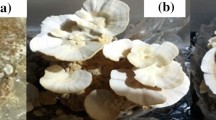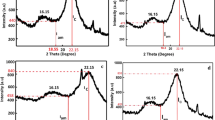Abstract
The degradation of lignocellulosic wastes such as paddy straw, sorghum stalk, and banana pseudostem was investigated during solid-state fermentation by edible mushrooms Pleurotus eous and Lentinus connotus. Biological efficiency of 55–65% was observed in paddy straw followed by sorghum stalk (45%) and banana pseudostem (33%) for both fungal species. The activity of extracellular enzymes, namely cellulase, polyphenol oxidase, and laccase, together with the content of cellulose, lignin, and phenols, was studied in spent substrates on seventh, 17th, and 27th days of spawning, and these values were used as indicators of the extent of lignocellulosic degradation by mushroom. Both the mushroom species proved to be efficient degraders of lignocellulosic biomass of paddy straw and sorghum stalk, and the extent of cellulose degradation was 63–72% of dry weight (d.w.), and lignin degradation was 23–30% of the d.w. In banana pseudostem, the extent of the degradation was observed to be only 15–22% of the d.w. for both lignin and cellulose. Preferential removal of cellulose during initial growth period and delayed degradation of lignin were observed in all three substrates. This is associated with decrease in activity of cellulase and polyphenol oxidase and increase in laccase activity with spawn aging in spent substrates. Thus, bioconversion of lignocellulosic biomass by P. eous and L. connotus offers a promising way to convert low-quality biomass into an improved human food.
Similar content being viewed by others
References
Zhang, R., Li, X., & Fadel, J. G. (2002). Bioresource Technology, 82, 277–284.
Vetayasuporn, S. (2006). Research Journal of Agricultural & Biological Science, 2(6), 548–551.
Mane, V. P., Patil, S. S., Syed, A. A., & Baig, M. M. V. (2007). Journal of Zhejiang University, Science B, 8(10), 745–751.
Marimuthu, T., & Krishnamoorthy, A. S. (1991). Glimpses of mushroom research in TNAU (2nd ed.). Coimbatore: Tamilnadu Agricultural University.
Bandari, T. P. S., Singh, R. N., & Verma, B. L. (1991). Indian Phytopathology, 44(4), 5–59.
Nallathambi, P., & Marimuthu, T. (1993). Mushroom Research, 2(2), 50–52.
Chahal, D. S. (1989). Journal of Fermentation and Bioengineering, 69(5), 334–338.
Hayes, W. A. (1988). New Scientist, 44, 450–452.
Rai, R. D., & Saxena, S. (1990). Mushroom Journal for the Tropics, 10, 69–73.
Bano, Z., & Srivastava, H. C. (1962). Food Science, 12, 363–368.
Royse, D. J., & Bahler, C. C. (1986). Applied and Environmental Microbiology, 52(6), 14–26.
Browning, B. L. (1967). Methods in Wood Chemistry (pp. 785–787). New York, USA.: Interscience.
Updegroff, D. M. (1969). Estimation of cellulose. Analytical Biochemistry, 32, 420–424.
Bray, H. G., & Thorpe, W. V. (1954). Methods of Biochemical Analysis, 1, 27–52.
Lowry, O. H., Rosenbrough, N. J., Farr, A. L., & Rendall, R. J. (1951). Journal of Biological Chemistry, 193, 265–275.
Criquet, S., Tagger, S., Voger, G., Iacazio, G., & Petit, J. (1999). Soil Biology & Biochemistry, 31, 1239–1244.
Robertson, L. D, & Koehn, R. D. (1978). Mycologia, 70(5), 1113–1121.
Mahadevan, A., & Sridhar, R. (1986). Methods in physiological plant pathology (pp. 214–216). Madras: Sivakami.
Esterbaner, H., Schwarzl, E., & Hayn, M. (1977). Analytical Biochemistry, 77, 486–489.
Snedecor, G. W., & Cochran, W. G. (1980). Statistical methods (7th ed.). Ames, IA: Iowa State University Press.
Garcha, H. S., Ohanda, S., & Khanna, P. (1984). Mushroom Newsletter for the Tropics, 5(1), 13–16.
Singh, A. K., Awasthi, S. K., & Dwivedi, R. (1992). National Academy Science Newsletter, 15(5), 137–139.
Bisaria, R., Madan, M., & Bisaria, V. S. (1987). Biological Wastes, 19, 239–255.
Belewu, M. A., & Belewu, K. Y. (2005). African Journal of Biotechnology, 4(12), 1401–1403.
Baysal, E., Peker, H., Yalinkilic, M. K., & Temiz, A. (2003). Bioresource Technology, 89, 95–97.
Diwakar, B., Munjal, R. L., & Bahukhandi, D. (1989). Indian Phytopathology, 42(4), 492–499.
Patrabansh, S., & Madan, M. (1995). Acta Biotechnologica, 15(1), 131–135.
Hammond, J. B. W. (1986). Mushroom Journal, 165, 316–320.
Ginterova, A., & Lazarova, A. (1987). Microbiology, 32, 434–437.
Ghosh, M., Mukherjee, R., & Nandi, B. (1998). Acta Biotechnologica, 18(3), 243–254.
Platt, M. W., Hadar, Y., Henis, Y., & Chet, I. (1983). European Journal of Applied Microbiology and Biotechnology, 17, 140–142.
Theradimani, M., & Marimuthu, T. (1992). Mushroom Research, 1, 49–51.
Kirk, T. K., Connors, W. J., & Zeikus, J. (1968). Applied and Environmental Microbiology, 32, 192–194.
Natarajan, K., Kaviyarasan, V., & Kadirvel, R. (1993). Mushroom Research, 2, 65–68.
Acknowledgment
The authors thank Dr.V. Ramamurthy, Head of the Department of Biotechnology, and Dr. Selvi Subramanian, Department of Biotechnology, PSG College of Technology, Coimbatore, for their valuable guidance and support. This work was supported by the Department of Biotechnology, Government of India, New Delhi, India (BT/PR4802/SPD/09/400/2004).
Author information
Authors and Affiliations
Corresponding author
Rights and permissions
About this article
Cite this article
Rani, P., Kalyani, N. & Prathiba, K. Evaluation of Lignocellulosic Wastes for Production of Edible Mushrooms. Appl Biochem Biotechnol 151, 151–159 (2008). https://doi.org/10.1007/s12010-008-8162-y
Received:
Accepted:
Published:
Issue Date:
DOI: https://doi.org/10.1007/s12010-008-8162-y




